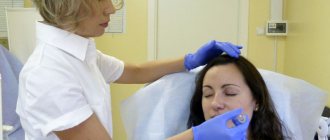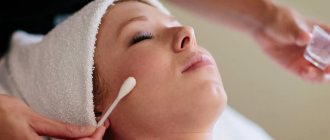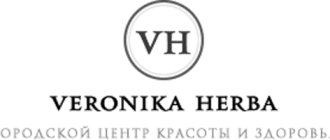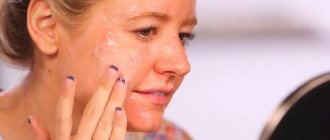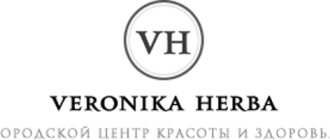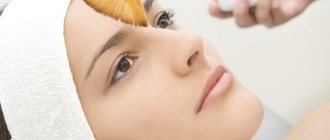Peeling: before and after
Before starting the procedure itself, it is strongly recommended to carry out a set of preparatory measures: consult a doctor and identify possible allergies; to avoid the occurrence of herpes, undergo a course of treatment with immunomodulators; prepare the skin by washing for two weeks with diluted lemon juice (only natural!) in a ratio of one teaspoon per glass of warm boiled water.
After the procedure is over, you may be alerted by strange sensations: the skin seems to be tight. Cosmetic products will help cope with excessive dry skin - primarily moisturizing and nourishing creams, which contain hyaluronic acid, amino acids, proteins, urea, hydrogels, alginates. However, be careful in your choice. Only a doctor can accurately determine the remedy that is right for you.
Active consumption of still water will help restore the lipid barrier, as well as the use of cosmetics containing antioxidants, ceramides and phospholipids, lanolin and wax, panthenol and natural oils - it will have a healing effect.
When talking about peeling, it is customary to distinguish three stages of exposure.
- In the first (superficial) procedure, only the upper (dead) layer of skin is affected. Care after the procedure in this case is simple. Peeling does not last long (on average - 3 days), and after 10 days there will be no trace of unpleasant sensations. You can wash your face with water on the second day, and apply cosmetics on the third, taking into account your skin type and provided that you use hypoallergenic products with a high level of ultraviolet protection and antibacterial properties. Do not forget to drink enough liquid (soda, juices and tea - not counts), monitor skin hydration and avoid repeated procedures for two weeks. Side effects with this type of peeling are limited to redness;
- at the second (middle) cleaning extends to the epidermis at the cellular level (including the basement membrane). In this case, care measures will be more serious. This is due to the high level of soft tissue injury. The full course of rehabilitation lasts up to one and a half months, and the period of peeling is limited to 10 days. The procedure is justified by the result, which allows you to get rid of even moderate wrinkles. You are allowed to wash your face for the first time on the third day, without using traditional soap (products with a pH level of 5-6 are acceptable). Earlier contacts with water are prohibited. Starting from the third day, you can use healing products, creams and masks with a calming effect. Omega-3 fatty acids are recommended. When leaving the room, it is necessary to apply a protective cream with an index of more than 50. As with superficial peeling, redness and swelling may occur;
- on the third (deep) treatment reaches the reticular and papillary layers of the dermis. Chemical peeling often involves a rehabilitation period in a clinical setting. The full course of rehabilitation takes up to six months, but the effect exceeds any expectations: you can visually look more than 10 years younger (a similar result can only be achieved with laser exposure). The recovery period takes place under the constant supervision of the attending physician; this method of peeling and rehabilitation is impossible at home and is fraught with severe consequences, including death. During the healing process, the patient is prescribed a course of antibiotics. Washing and any contact of the treated area with water is possible no earlier than the fourth day! Liquid intake is recommended through a cocktail straw. Any skin care products containing alcohol are excluded. The use of specialized medicinal cosmetics and protective creams with the maximum degree of protection against ultraviolet radiation is prescribed.
Side effects include temporary darkening of the skin.
Contraindications for chemical peels:
- active viral infections (herpes, warts) and bacterial infections;
- active inflammatory skin diseases (acne, psoriasis, eczema);
- pregnancy;
- lactation;
- oral retinoid therapy (isotretinoin) within the past 6 months;
- severe, incurable forms of acne;
- allergy to substances containing vitamin C;
- autoimmune skin diseases (for example, collagenosis);
- skin damage, abrasions, cuts, changes in the subcutaneous layers;
- fresh scars;
- condition after surgical operations on the face (in the last 3-6 months);
- taking certain medications;
- keloid scars;
- after a cryotherapy procedure up to 6 months;
- fresh tan;
- light treatment;
- mental disorders;
- metabolic diseases such as diabetes;
- people with dark skin, that is, phototypes IV and VI (chemical peels are intended for people with skin phototypes I-III);
Recommendations and possible complications after peeling
In order not to get confused in the recommendations, we decided to arrange them for you according to the time criterion. So:
- on the first day, washing, using cosmetics and creams, physical touching, and leaving the room are contraindicated;
- From the 2nd to the 14th day, experiments with cosmetics, exposure to ultraviolet rays (both solar and artificial), visiting saunas and baths, hot baths, walking without protective cream, stressful situations, active physical activity, and drinking alcohol are not allowed. and scrub procedures;
- The general rule is not to forcefully exfoliate your skin. It is necessary to wait for complete healing, after which all problems will disappear on their own. Do-it-yourself activities in the early stages can lead to scars!
Swelling, redness, dehydration, burns and peeling are natural side effects of peeling. The solution is to use protective, moisturizing and nourishing creams, medications high in antioxidants, drinking water, and physical and emotional rest.
However, complications are possible that require specific therapy: for example, in the event of herpes, antiherpetic drugs are prescribed in combination with pulse therapy; the active appearance of acne is blocked by zinc-containing products and antiseptics for external use; in case of pigmentation disorders, drug treatment is determined by the doctor, and allergic reactions will be avoided by preliminary examination and the use of antihistamines and hypoallergenic drugs.
Side effects disappear on their own within a few days (with proper care). It is impossible to predict their appearance, since each person’s body has its own individual characteristics. If we talk about complications, they usually do not arise on their own, which means that the prerequisites for their occurrence were violations of the rules of the procedure or care during the rehabilitation period.
What types of chemical peels are there?
Superficial peeling
It is the most gentle type of procedure. It affects only a few layers of the epidermis. It can be used on young skin that has minor problems. The effect of the procedure is short-lived; from 4 to 10 sessions will be required.
This chemical peeling is also called fruit peeling - the active components are fruit acids.
Glycolic acid is considered the most effective because it has the greatest penetrating power. After exposure of the skin to such acid, wrinkles become almost invisible. Glycolic acid also accelerates the synthesis of intercellular substances - flabby and dry skin becomes more hydrated.
The following acids can also be used for superficial peeling:
- retinoic – promotes rapid renewal of cells and blood vessels, accelerates metabolic processes, the skin is saturated with oxygen and nutrients;
- fetin - stops the process of skin aging, quickly removes unnecessary cells;
- Kojeva – is an antioxidant;
- azelaic acid – removes foci of inflammation, destroys microbes, whitens the skin, promotes better collagen synthesis. Used to eliminate scars.
Medium peeling
Medium facial peeling is used to target deeper layers. The effect is noticeable after the first session. A repeat procedure may be required after 30 days. After such peeling, various types of peeling appear, which disappear within a week.
The best drugs for this procedure are those that have a gel structure. Only a specialist can select the correct acid concentration.
Trichloroacetic acid TCA is used on sensitive skin. Salicylic acid fights age spots and shallow wrinkles.
Deep peeling
With this chemical peeling, the epidermis is rejected and the basement membrane is affected. Therefore, this procedure is carried out in a hospital setting using anesthesia. Deep peeling can remove the deepest wrinkles and scars. The skin is exposed to phenol.
They only do it once. Full recovery will take approximately 5 months.
Chemical cleaning of leather is best done in late autumn or early winter. Because after the procedure the skin becomes very susceptible to ultraviolet rays.
All recommendations of a specialist should be followed. Do not peel off the crusts, use moisturizing and healing products. When leaving home, even in cloudy weather, you should apply sunscreen.




